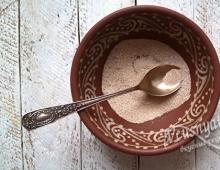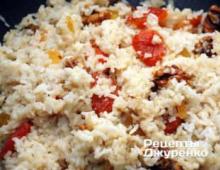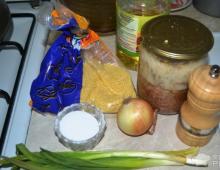Malt extracts are a storehouse of useful substances. Barley malt extract Barley malt extract
Barley malt extract is a natural product extracted from sprouted barley grains, which are dried at a certain stage of germination and fermentation to preserve the chemical composition and maximum beneficial properties. Next, they are ground, mixed with water to form a solution and undergo further processing followed by clarification.
Barley malt extract contains carbohydrates, trace elements, minerals and amino acids, cereal starch, sugars, enzymes, and fiber. It looks like a thick, viscous, brown liquid (the shade depends on the degree of lightening) with a sweetish taste (there may be notes of caramel) and the aroma of barley.
Beneficial properties of barley malt extract
The extract is completely soluble in water, imparts a pleasant taste, color and smell to various products, acts as a natural sweetener - its sweetness is about 60% of that of sucrose. In addition, it has the ability to retain moisture, reduce acidity, and extend the shelf life of food and pharmaceutical products when included in the composition.
Malt barley extract is a source of:
- Selena;
- phosphorus;
- manganese;
- magnesium;
- calcium;
- vitamins A, E and group B.
The amino acids in its composition stimulate protein metabolism, growth and muscle development in the human body. Due to its fiber content, it is easily digestible and has a positive effect on the gastrointestinal tract:
- activates digestion;
- enhances intestinal motility;
- helps remove waste and toxins.
Dietary fiber and vitamin B4 create a choleretic effect, which helps prevent the formation of bile stagnation and the development of cholelithiasis. Vitamins A, E, B2 and B3 coat the mucous membranes of the stomach and intestines, promoting their healing. In addition, barley malt extract has general strengthening and restorative properties, is a source of energy and helps activate the brain.
Areas of application of barley malt extract
The rich chemical composition and the above properties make the use of barley malt extract useful:
- for the prevention of gastritis, colitis, enterocolitis, stomach and duodenal ulcers*;
- to prevent cholecystitis, inflammation in the bile ducts;
- to restore the gastrointestinal tract after prolonged intoxication;
- for recovery after surgery;
- to increase endurance and build muscle during intense training;
- for asthenic conditions (chronic fatigue, weakness);
- to stabilize blood sugar levels in diabetes**.
**Malt allows you to slow down the breakdown of carbohydrates and avoid sudden jumps in glucose levels, affects the production of insulin by the pancreas and is one of the best sweeteners.
To date, barley malt extract has been included in syrups from the Apifitofarm company.
The production of beer wort from malt and hops is a complex, labor-intensive process. The main stage of wort preparation - mashing - consists of mixing malt with water and maintaining this mixture (mash) at certain temperatures that are optimal for the action of enzymes.
The purpose of mashing is to obtain the maximum amount of useful extractive substances of the malt, separated from the grain during the filtering process.
By evaporating water from the wort, this extract can be obtained in concentrated form.
Malt extract is a viscous, dark-colored syrup with a very sweet taste that contains all the nutrients of the wort.
Malt extract is used as a structuring and concentrating component in the form of syrup or powder.
It is also used in baking and chocolate production as a sweetener and improver, and recently there has been an increasing need for malt extract for home brewing. Many home brewers seek to avoid the mashing process and, above all, the labor-intensive process of filtering the mash, by starting their brew with malt extract diluted with water in the form of normal wort. The wort from the unhopped extract is then boiled with hops. This malt extract can be purchased from appropriate stores.
The quality of malt extract is highly dependent on the quality of the wort from which it was prepared. From the very beginning, the mash is made thicker than in normal brewing because it would otherwise require too much energy to evaporate the water from the wort. The wort is concentrated to an extract content of 75-80%, but to facilitate reverse dissolution, the degree of concentration is often set to a much lower level.
When water evaporates from wort at normal pressure and a temperature of 100°C, it takes a long time, and many Maillard reaction products (melanoidins and Strecker aldehydes) are formed in the wort. The wort darkens greatly and, due to the increased thermal load, acquires corresponding undesirable taste changes. To avoid this, water is evaporated in a vacuum at a lower temperature (at a pressure of 0.1 bar the boiling point is about 46°C, at a pressure of 0.2 bar this temperature is 60°C). The condition for carrying out this process is the availability of the following equipment:
Hermetically sealed vacuum boiler with stirrer,
Sealed piping system,
Vacuum pump.
Under these conditions, the quality of the concentrated wort can be fully preserved until repeated dilution.
For evaporation, special vacuum evaporation units are used.
Light barley malt extract
Light barley malt extract
TU 9184-002-05154587-13
Product Description:
Barley malt extracts are produced by mashing crushed barley malt and barley flour with water. The mash mass is kept in the mash tun for certain periods of time at a given temperature according to the programmed brewing diagram. At this time, the dissolution and breakdown of the constituent substances of malt (starch, water-soluble protein substances, flavoring and mineral substances) occurs. Next, the process of saccharification and filtration of the mash mass occurs to obtain liquid wort. After this, the wort is boiled gently to bring the percentage of dry substances to the standard value.
Composition of raw materials for the production of barley malt extracts:
Brewing barley malt according to GOST 29294;
Barley according to GOST 5060 for malt production;
Barley according to GOST 28672 for flour;
Areas of use
The main area of application of barley-malt extracts is the replacement of traditional and synthetic sugars in baking, preparation of various sweets and desserts. Due to the high content of maltose (malt) sugar, barley malt extracts can be used as a healthier substitute for both traditional sugars - sucrose, glucose, fructose, high fructose syrup, and synthetic sugar analogues - xylitol, sorbitol, aspartame.
Using barley malt extracts the following is produced:
- Bakery products;
- Dry (cereal) breakfasts, cereal flakes, kozinaki;
- Cereal bars, granola, snacks and muesli;
- Gingerbread cookies, cookies, crackers, muffins, biscuits, biscuits;
- Products for children's, sports and diabetic nutrition;
- Ice cream;
- Beer on a shortened cycle;
- Malt whiskey based on barley with a shortened production cycle;
Purposes of using barley malt extracts
- Color correction – as a natural ingredient instead of using chemical dye Caramel color E150
- Sweetness correction – as a natural sweetener for baking, production of soft drinks and dairy drinks
- Enhancing aroma – to add malt flavor to foods and drinks
- Extending the shelf life of finished products
- Concealing unwanted tastes and odors
- Fermentation activator - due to the content of fermentable and easily digestible sugar maltose, barley and malt extracts are an excellent fermentation activator in the production of fermented alcoholic drinks - tinctures and fruit wines.
- Extending the shelf life of food and pharmaceutical products by including barley malt extract in the product composition.
Benefits of using barley malt extracts
Barley and malt extracts promote more active yeast growth, thereby increasing the volume of baked goods. Keeps the crumb and crust elastic longer. They help improve the appearance, achieve uniform porosity, a crispy crust with a beautiful color, friability, taste and long shelf life of bakery products. The therapeutic and preventive effect of barley and malt extracts is determined by the presence in them of a number of biologically active substances, vitamins and rich mineral composition. Barley malt extracts are a valuable source of healthy, easily digestible sugars - maltose (up to 50%), maltotriose (10%-18%) and at the same time have a low content of glucose and fructose.
100 grams of barley malt extract contains:
Potassium – 351 mg;
Phosphorus – 100 mg;
Sodium – 85 mg;
Magnesium – 37 mg;
Calcium – 10 mg;
Barley malt extracts are a rich source of dietary amino acids - leucine, phenylalanine, tyrosine, alanine, isoleucine, tryptophan, histidine with a content of 7 to 29 mg per 100 grams of product. The amino acids in their composition stimulate protein metabolism, growth and muscle development in the human body. Activate digestion, enhance intestinal motility, help remove waste and toxins.
What is malt extract?
Malt extract is a concentrated and/or dried essence from barley malt. Most of the malt produced in the world is used in the food industry, such as making malted milk, breakfast cereals, baking dough additives, and even pet food. There are two main varieties of barley: malt and fodder, and several subvarieties within each. It is believed that barley from which food extracts are made (grades 3 and 4) is worse than malt and pure varieties. Low grade barley grains are usually small, with a high protein content, poorly digestible starch and a thick husk that is not suitable for consumption. Brewing uses the highest quality barley, and in order to brew a good batch of beer, you need to be sure that the extract for it is made from exactly this (beer) barley.
To prepare the extract, barley grains are first soaked and dried to allow the grain to begin to sprout. While the sprout breaks through the grain, enzymes are activated that process the starch necessary to nourish the embryo, and proteins into sugars and amino acids that the sprout will need in the future. It is important for brewers to be able to use these enzymes and starch reserves. As soon as the grain begins to germinate, it is dried in a special oven to stop the process at the most profitable stage for brewers and preserve all the necessary substances. It is this grain at a fixed stage of germination that is called malt. There are many varieties of malt, distinguished by taste, smell and color, and the type of beer depends on their choice. There are lager malts, pale malts, Vienna malts, Munich malts, kilned malts, roasted malts, and even chocolate malts.
The production of malt extract in a plant is akin to the first stage of brewing from whole barley grains. Malted barley is ground and soaked in hot water to renew and accelerate the formation of enzymes that convert the grain's starchy reserves into fermentable sugars. As a result, a solution of sugars is formed, which is called wort. It is this that the brewer first boils, then mixes with hops and adds yeast for fermentation. To make a concentrated extract from the wort instead of continuing to cook, it is placed in an evaporator where it thickens. In other words, malt extract is simply concentrated wort, so if you buy it and dilute it at home, you get regular industrial wort. Depending on what type of beer you want to make, you can take extract from one or more varieties.
The wort is boiled for two reasons: to destroy the heat-stable proteins that otherwise make the beer cloudy and spoil the taste and aroma of the beer, and to isomerize the alpha acids in the hops to impart bitterness to the beer.

Rice. 18. Malt extract plant (photo courtesy of Briess Malt & Ingredients Company)
This is done both at home and in industrial breweries, although factories do not always immediately add hops to the extract. If hops are added later, then the extract is boiled only to destroy the proteins, and then when adding hops to the wort you need to boil it additionally at home. After boiling at the factory, the wort is placed in vacuum chambers for dehydration so that the extract can be stored longer without preservatives. In these chambers, the solution is evaporated under pressure, which prevents the sugar from caramelizing, since the temperature does not reach 100°C, and preserves the taste and smell of the extract. To make an extract with the addition of hops, it can be added both when the grains are first brewed, and already in the finished extract in the form of hop iso-alpha acids. So, you can see that extract for home brewing is quite difficult to prepare.
It is sold both in liquid (syrup) and powder form. Syrups have about 20% water content, so 4 kg
dry malt extract approximately corresponds to 5 kg of liquid. To produce a dry extract, the liquid extract is heated and sprayed in a high, hot chamber. Small droplets dry quickly and settle on the walls of the chamber. Typically, dry extracts do not contain hops and are generally similar to syrup.


